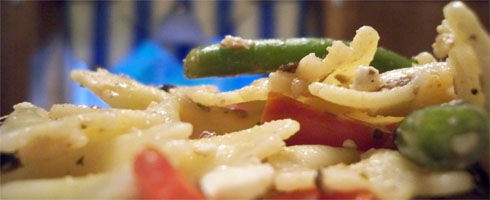Heirloom Vegetables
19 Apr

Until recently, farmers and plant breeders saved the seeds of the most desirable plants from each year’s harvest for the next year’s crop. Gardeners gave their surplus to friends and relatives, and especially noteworthy varieties found their way to seed companies for wider distribution. Today with larger mechanized farms, fewer gardeners harvesting seeds, and more hybrids and sterile seeds, many heirloom varieties have become rare or extinct.
This amounts to more than just the old being pushed out by the new. Heirlooms are not the first choice for agribusiness where concerns of perishability, yield, shipping endurance, pest resistance, and appearance are more important than flavor. As more old varieties are lost, we also lose a broad genetic base. This creates a less diverse source of food crops that may not be as adaptable or hardy.
What can the consumer do? If you enjoy gardening, grow heirloom vegetables yourself. Patronize farmers’ markets and produce stands where farmers label and promote heirlooms. Buy locally grown fresh produce to support growers who can produce a wider range of varieties than what is offered at typical supermarkets. Another option is to join Community Supported Agriculture (CSA) to encourage regional small-scale farms. CSA members buy shares in the produce they will eventually receive. Most CSAs encourage participation, including input on what to grow. For more information, visit www.reeusda.gov/csa.
Here is a list of a few favorite heirloom varieties that can be found if you look hard enough.
BEANS: Cherokee trail of tears – Carried by the Cherokees on their forced march west to Oklahoma. These are very tasty purple podded beans.
Kentucky wonder – A classic green bean, excellent flavor, great fresh, frozen, or canned.
Jacob’s cattle – White beans attractively spotted with maroon. Good for all bean dishes, especially soups or baked beans.
BEETS: Chioggia – Strong-growing beautiful Italian variety. Horizontal slices show alternating rings of rose pink and white. Nice in salads.
Golden beet – Brilliantly colored roots that are also particularly sweet.
BROCCOLI: Romanesco – Spiraling florets form psychedelic patterns on this nutty-flavored Italian heirloom.
CABBAGE: Early jersey wakefield – A very tender and sweet English variety from the eighteenth century.
CARROTS: Scarlet nantes – Non-fibrous texture and sweet flavor for all uses, particularly jucies.
CORN: Golden bantam – Introduced in 1902, this is still a popular sweet corn for home gardeners.
EGGPLANT: Rosa bianca – Delicate flavor, smooth texture, and unusual lavender stripes on a white fruit make this Italian heirloom worth trying.
KALE: Russian red (ragged jack) – Brought to North America by Russian traders, this is a favorite variety of a very nutritious cooking green. The flat, violet-veined leaves are milder and more tender than other kales.
LEEKS: Black seeded simpson – A crisp, tasty, classic looseleaf with bright yellow leaves.
Forellen schluss (speckled trout) – An Austrian heirloom with very tender, light green leaves speckled with maroon.
MUSTARD GREENS: Mizuna – A Japanese type that is versatile; baby greens are good in salad, mature leaves cook quickly for soups or stir-frys. Plant has a lovely feathery, fern-like habit.
Tatsoi – A Chinese heirloom with deep green leaves on white stalks, similar to pak choi, but smaller. Use like mizuna.
PEAS: Golden sweet – Unusual chartreuse snow pea, new to this continent but grown for centuries in India. Eat the pods before peas develop.
SWISS CHARD: Five color silverbeet – The flavor of this Swiss chard is not different from the green variety, but the gorgeous color range of red, pink, yellow, orange, and cream range stops people in their tracks. Good in both flower and vegetable gardens as an edible ornamental.
SQUASH: Delicata – A nineteenth-century introduction valued today for its dry, sweet flesh. Sized just right for individual servings of stuffed squash.
TOMATOES: Amana orange – Huge slicing tomatoes with rich flavor. Combine with other colored slices for festive platters.
Black krim – Russian heirloom with full flavor and purplish-red fruits that turn almost black in hot weather.
Brandywine – Large pink beefsteak, good for slicing, intense tomato-ey flavor. An Amish family heirloom that has become very popular.
Cherokee purple – Tennessee variety reputed to be one of the sweetest. Unusually colored rose, green, and brown.
Costoluto genovese – Italian variety good for sauce, juice, fresh eating. Somewhat tart, bright red.
Green zebra – An introduction from the eighties that is grouped with heirlooms because of its appearance and non-hybrid status. Zesty tart-and-sweet flesh that is, not surprisingly, striped yellow to yellow-green.
Joya de oaxaca – Mexican variety that is god both fresh and dried. Yellow flesh streaked with pink, orange, and red. Highly flavorful.
Mortgage lifter (radiator charlie’s mortgage lifter) – Huge beefsteaks that enabled the breeder to pay off his mortgage by selling the plants and seeds of this exceptional tomato.
Yellow Pear – Prolific producer of sweet, juicy small tomatoes that are low in acid and very flavorful.
Moosewood Restaurant New Classics, Copyright 2001, Moosewood, Inc., Clarkson Potter, Publishers.




